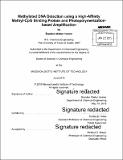| dc.contributor.advisor | Hadley D. Sikes. | en_US |
| dc.contributor.author | Heimer, Brandon Walter | en_US |
| dc.contributor.other | Massachusetts Institute of Technology. Department of Chemical Engineering. | en_US |
| dc.date.accessioned | 2015-09-17T19:12:45Z | |
| dc.date.available | 2015-09-17T19:12:45Z | |
| dc.date.copyright | 2015 | en_US |
| dc.date.issued | 2015 | en_US |
| dc.identifier.uri | http://hdl.handle.net/1721.1/98796 | |
| dc.description | Thesis: Sc. D., Massachusetts Institute of Technology, Department of Chemical Engineering, 2015. | en_US |
| dc.description | Cataloged from PDF version of thesis. | en_US |
| dc.description | Includes bibliographical references (pages 123-132). | en_US |
| dc.description.abstract | Methylation at the 5 position of the cytosine base, when followed by guanine (CpG) in the promoter region of a protein-coding gene, is an epigenetic modification that has been shown to be involved in gene silencing. While important for regulating many normal, cellular processes, aberrant DNA methylation has been implicated in the development of human diseases such as cancer. Medical research has begun to identify hypermethylated gene promoters that can be used as predictive, prognostic, and diagnostic biomarkers. Current technologies for DNA methylation detection, however, rely on sodium bisulfite conversion of unmethylated cytosine bases to urasil in the target DNA. Bisulfite treatment is time consuming to perform, degrades >90% of the DNA, and is susceptible to incomplete conversion which can lead to false results. As such, a method that eliminates both chemical conversion and PCR amplification of DNA would enable significantly lower-cost and rapid DNA methylation analysis in the clinic. Methyl binding domain (MBD) family proteins specifically bind double-stranded, methylated DNA which makes them excellent transducers for DNA methylation in biosensing applications. I displayed three of the core members MBD1, MBD2, and MBD4 on the surface of Saccharomyces cerevisiae yeast cells. Using the yeast display platform, I determined the equilibrium dissociation constant of human MBD2 (hMBD2) to be 5.9+/-1.3 nM for binding to singly methylated DNA. I further used the yeast display platform to evolve the hMBD2 protein for improved binding affinity. Affecting five amino acid substitutions doubled the affinity of the wildtype protein to 3.1+/-1.0 nM. Further, concatenating the high-affinity MBD variant from 1x to 3x and expressing it in Escherichia coli as a green fluorescent protein (GFP) fusion improved affinity 6-fold for interfacial binding. After optimizing the expression and purification of engineered MBD-GFP proteins in E. coli, I developed a simple method for detecting methylated DNA fragments from the MGMT gene promoter. A defining feature is that target oligonucleotides from the test sample hybridize directly to capture probes printed in 300 pm diameter spots on an inexpensive biochip without requiring bisulfite conversion. Sub-nanomolar concentrations (0.3 nM) of methylated DNA duplexes are detected using an MBD-GFP protein to transduce binding to either a fluorescent or colorimetric (visible hydrogel) signal formed by photopolymerization with short (<2 min) reaction times. | en_US |
| dc.description.statementofresponsibility | by Brandon Walter Heimer. | en_US |
| dc.format.extent | 132 pages | en_US |
| dc.language.iso | eng | en_US |
| dc.publisher | Massachusetts Institute of Technology | en_US |
| dc.rights | M.I.T. theses are protected by copyright. They may be viewed from this source for any purpose, but reproduction or distribution in any format is prohibited without written permission. See provided URL for inquiries about permission. | en_US |
| dc.rights.uri | http://dspace.mit.edu/handle/1721.1/7582 | en_US |
| dc.subject | Chemical Engineering. | en_US |
| dc.title | Methylated DNA detection using a high-affinity methyl-CpG binding protein and photopolymerization-based amplification | en_US |
| dc.type | Thesis | en_US |
| dc.description.degree | Sc. D. | en_US |
| dc.contributor.department | Massachusetts Institute of Technology. Department of Chemical Engineering | |
| dc.identifier.oclc | 921145450 | en_US |
